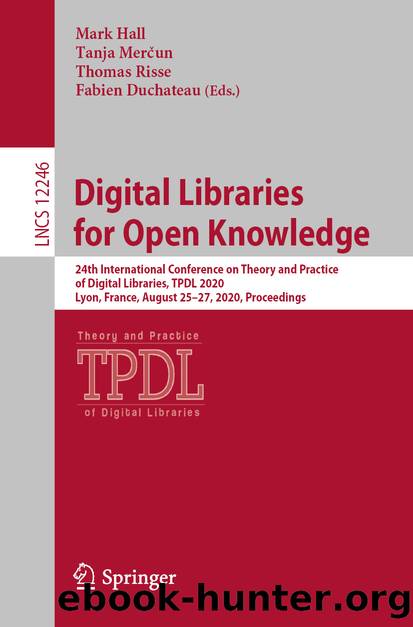Digital Libraries for Open Knowledge by Unknown

Author:Unknown
Language: eng
Format: epub
ISBN: 9783030549565
Publisher: Springer International Publishing
DOIs identifying content to which we have access due to institutional subscription and licensing agreements (SUB) versus those we do not (nSUB).
We utilize our corpus to analyze responses of DOIs identifying OA content and the corpus to investigate responses for DOIs that lead to licensed content. Identifying OA content can be a non-trivial task but rather than manually inspecting all of the 10, 000 DOIs, we rely on the popular unpaywall service and their API9 to determine whether a DOI identifies OA content. To identify licensed content, we match institutional subscription information to base URIs of dereferenced DOIs. Table 2 summarizes the resulting numbers of DOIs and their access levels in our corpora. We realize that the numbers for licensed content may not be representative as other institutions likely have different subscription levels to scholarly publishers. However, given that we consider our DOI corpus representative, we are confident the ratios represent a realistic scenario.
Figure 3 shows the final response codes for the corpus, similar in style to Fig. 2, with the DOIs along the y-axis and our four request methods on the x-axis. Figure 3a shows the response codes for the 973 OA DOIs and Fig. 3b shows the remaining 9, 027 DOIs that identify non-OA content. The first observation we can make from these two figures is that OA DOIs return 200-level responses for all requests more often than non-OA DOIs with versus . We can further see that even for OA DOIs the GET and GET+ method do not work well. of DOIs return a 300-level response for these two methods but return a 200-level response for the HEAD and Chrome methods. If we compare Fig. 3 with 2a we can see a clear resemblance between Fig. 2a, the figure for the overall corpus, and Fig. 3b, the figure for non-OA DOIs. Given the fact that we have many more non-OA DOIs this may not be all that surprising but it is worth noting that by far the vast majority of 400- and 500-level responses come from non-OA DOIs. Given our dataset, this observation indicates that OA content providers show more consistency across the board compared to non-OA providers and their positive effect to the overall picture (Fig. 2a) is visible. A larger scale analysis of OA versus non-OA content providers is needed, however, to more reliably underline this observation. We leave such effort for future work.Table 2.Distribution of DOIs leading to OA and nOA resources as well as to SUB and nSUB content in our dataset.
Download
This site does not store any files on its server. We only index and link to content provided by other sites. Please contact the content providers to delete copyright contents if any and email us, we'll remove relevant links or contents immediately.
Cecilia; Or, Memoirs of an Heiress — Volume 1 by Fanny Burney(32078)
Cecilia; Or, Memoirs of an Heiress — Volume 3 by Fanny Burney(31470)
Cecilia; Or, Memoirs of an Heiress — Volume 2 by Fanny Burney(31420)
The Great Music City by Andrea Baker(30797)
We're Going to Need More Wine by Gabrielle Union(18646)
All the Missing Girls by Megan Miranda(14798)
Pimp by Iceberg Slim(13803)
Bombshells: Glamour Girls of a Lifetime by Sullivan Steve(13701)
Fifty Shades Freed by E L James(12927)
Talking to Strangers by Malcolm Gladwell(12891)
Norse Mythology by Gaiman Neil(12863)
For the Love of Europe by Rick Steves(11567)
Crazy Rich Asians by Kevin Kwan(8902)
Mindhunter: Inside the FBI's Elite Serial Crime Unit by John E. Douglas & Mark Olshaker(8725)
The Lost Art of Listening by Michael P. Nichols(7170)
Enlightenment Now: The Case for Reason, Science, Humanism, and Progress by Steven Pinker(6881)
The Four Agreements by Don Miguel Ruiz(6328)
Bad Blood by John Carreyrou(6286)
Weapons of Math Destruction by Cathy O'Neil(5853)
